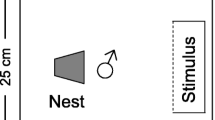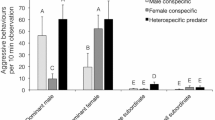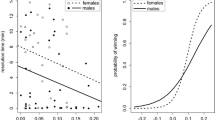Abstract
The African cichlid fish Astatotilapia burtoni represents a valuable model system for studies of social decision-making due to its socially mediated phenotypic plasticity. The males reversibly transition in social status from reproductively dominant and territorial (DOM) to submissive and non-territorial (SUB). Males are traditionally categorized into these two behavioral phenotypes by observational scoring. There is evidence, however, that this dichotomous categorization might not capture the behavioral plasticity displayed by individuals transitioning between SUB and DOM status. To test this concept, we used focal observations of intrasexual conflict behavior in fish communities combined with a modified analysis of the ethogram typically used in A. burtoni. Results revealed a cluster of males close to the crossover point between SUB and DOM status as defined by the traditional dominance index. These intermediate males showed the highest frequency of intrasexual conflict behaviors, distinct behavioral responses to threats, and body pigment signaling displays that distinguish them from prototypical SUBs and DOMs. As such, our results provide a noninvasive behavioral metric to categorize A. burtoni males into three groups, thus further capturing the complex social dynamic of this model organism.







Similar content being viewed by others
References
Ågren G (1984) Pair formation in the Mongolian gerbil. Anim Behav 32:528–535. doi:10.1016/0003-3472(89)90002-X
Baerends GP, Baerends-Van Roon JM (1950) An introduction to the study of the ethology of cichlid fishes. Behaviour [Suppl] 1:1–242
Burmeister SS, Jarvis ED, Fernald RD (2005) Rapid behavioral and genomic responses to social opportunity. PLoS Biol 3:1997–2004. doi:10.1371/journal.pbio.0030363
Černá K, Zemenová M, Macháčková L, Kolínová Z, Straka J (2013) Neighbourhood society: nesting dynamics, usurpations and social behaviour in solitary bees. PLoS One 8:1–9. doi:10.1371/journal.pone.0073806
Chen C, Fernald RD (2011) Visual information alone changes behavior and physiology during social interactions in a cichlid fish (Astatotilapia burtoni). PLoS One 6:1–12. doi:10.1371/journal.pone.0020313
Clement TS, Parikh V, Schrumpf M, Fernald RD (2005) Behavioral coping strategies in a cichlid fish: the role of social status and acute stress response in direct and displaced aggression. Horm Behav 47:336–342. doi:10.1016/j.yhbeh.2004.11.014
Desjardins JK, Fernald RD (2008) How do social dominance and social information influence reproduction and the brain? Integr Comp Biol 48:596–603. doi:10.1093/icb/icn089
Desjardins JK, Hofmann HA, Fernald RD (2012) Social context influences aggressive and courtship behavior in a cichlid fish. PLoS One 7:32781. doi:10.1371/journal.pone.0032781
Dijkstra PD, Schaafsma S, Hofmann HA, Groothuis TGG (2012) ‘Winner effect’ without winning: unresolved social conflicts increase the probability of winning a subsequent contest in a cichlid fish. Phys Behav 105:489–492. doi:10.1016/j.physbeh.2011.08.029
Dittus WPJ (1977) The social regulation of population density and age-sex distribution in the toque monkey. Behaviour 63:281–322. doi:10.1163/156853977X00450
Drews C (1993) The concept and definition of dominance in animal behaviour. Behaviour 125:283–313
Dugatkin LA, Druen M (2004) The social implications of winner and loser effects. Proc R Soc Lond B 271:S488–S489. doi:10.1098/rsbl2004.0234
Dugatkin LA, Earley RL (2004) Individual recognition, dominance hierarchies and winner and loser effects. Proc R Soc Lond B 271:1537–1540. doi:10.1098/rspb.2004.2777
Erickson JG (1967) Social hierarchy, territoriality, and stress reactions in sunfish. Phys Zool 40:40–48
Fernald RD (1977) Quantitative behavioural observations of Haplochromis burtoni under semi-natural conditions. Anim Behav 25:643–653. doi:10.1016/0003-3472(77)90115-4
Fernald RD (2007) The social control of reproduction: physiological, cellular, and molecular consequences of social status. In: Platek SM, Keenan JP, Shackelford TK (eds) Evolutionary cognitive neuroscience. MIT, Cambridge, MA, pp 197–216
Fernald RD, Hirata NR (1977) Field study of Haplochromis burtoni: quantitative behavioural observations. Anim Behav 25:965–975
Fernald RD, Hirata NR (1979) The ontogeny of social behavior and body coloration of the African cichlid fish Haplochromis burtoni. Z Tierpsychol 50:180–187. doi:10.1111/j.1439-0310.1979.tb01025.x
Ferno A (1987) Aggressive behaviour between territorial cichlids (Astatotilapia burtoni) in relation to rank and territorial stability. Behaviour 103:241–258. doi:10.1163/156853987X00189
Fox HE, White SA, Kao MHF, Fernald RD (1997) Stress and dominance in a social fish. J Neurosci 17:6463–6469
Furness AI, Lee K, Reznick DN (2015) Adaptation in a variable environment: phenotypic plasticity and bet-hedging during egg diapause and hatching in an annual killifish. Evol 69:1461–1475. doi:10.1111/evo.12669
Genner MJ, Turner GF, Hawkins SJ (1999) Resource control by territorial male cichlid fish in Lake Malawi. J Anim Ecol 68:522–529. doi:10.1046/j.1365-2656.1999.00301.x
Greenwood AK, Fernald RD (2004) Social regulation of the electrical properties of gonadotropin-releasing hormone neurons in a cichlid fish (Astatotilapia burtoni). Biol Reprod 71:909–918. doi:10.1095/biolreprod.104.030072
Grosenick L, Clement TS, Fernald RD (2007) Fish can infer social rank by observation. Nature 445:429–432. doi:10.1038/nature05511
Günther ACLG (1894) Descriptions of the reptiles and fishes collected by Mr. E. Coode-Hore on Lake Tanganyika. Proc Zool Soc Lond 1893 (Part 4):628–632
Harris S, Ramnarine IW, Smith HG, Pettersson LB (2010) Picking personalities apart: estimating the influence of predation, sex and body size on boldness in the guppy Poecilia reticulata. Oikos 119:1711–1718
Heiligenberg W, Kramer U, Schulz V (1972) The angular orientation of the black eye-bar in Haplochromis burtoni (Cichlidae, Pisces), and its relevance to aggressivity. Zeitschr Vergl Physiol 76:168–176
Hofmann HA, Benson ME, Fernald RD (1999) Social status regulates growth rate: consequences for life-history strategies. Proc Natl Acad Sci USA 96:14171–14176. doi:10.1073/pnas.96.24.14171
Judge PG, De Waal FBM (1993) Conflict avoidance among rhesus monkeys: coping with short-term crowding. Anim Behav 46:221–232
Korzan WJ, Robison RR, Zhao S, Fernald RD (2008) Color change as a potential behavioral strategy. Horm Behav 54:463–470. doi:10.1016/j/yhbeh.2008.05.006
Kustan JM, Maruska KP, Fernald RD (2011) Subordinate male cichlids retain reproductive competence during social suppression. Proc R Soc Lond B 279:434–443. doi:10.1098/rspb.2011.0997
Lederer RJ (1981) Facultative territoriality in Townsend’s solitaire (Myadestes townsendi). Southwest Nat 25:461–467
Maher CR, Lott DF (2000) A review of ecological determinants of territoriality within vertebrate species. Am Midl Nat 143:1–29. doi:10.1674/0003-0031(2000)143[0001:AROEDO]2.0.CO;2
Maruska KP, Fernald RD (2010) Behavioral and physiological plasticity: rapid changes during social ascent in an African cichlid fish. Horm Behav 58:230–240. doi:10.1016/j.yhbeh.2010.03.011
Maruska KP, Carpenter RE, Fernald RD (2012) Characterization of cell proliferation throughout the brain of the African cichlid fish Astatotilapia burtoni and its regulation by social status. J Comp Neurol 520:3471–3491
Mautz BS, Jennions MD (2011) The effect of competitor presence and relative competitive ability on male mate choice. Behav Ecol 22:769–775: doi:10.1093/beheco/arr048
Muske LE, Fernald RD (1987) Control of a teleost social signal. II. Anatomical and physiological specializations of chromatophores. J Comp Physiol 160:99–107. doi:10.1007/BF00613445
Neumeister H, Whitaker KW, Hofmann HA, Preuss T (2010) Social and ecological regulation of a decision-making circuit. J Neurophysiol 104:3180–3188. doi:10.1152/jn.00574.2010
Oliveira RF (2012) Social plasticity in fish, integrating mechanisms and function. J Fish Biol 81:2127–2150
Oliveira RF, Hirschenhauser K, Carneiro LA, Canario AVM (2002) Social modulation of androgen levels in male teleost fish. Comp Biochem Physiol 132:203–215. doi:10.1016/S1096-4959(01)00523-1
Oliveira RF, Carneiro LA, Canario AVM (2005) No hormonal response in tied fights. Nature 437:207–208. doi:10.1038/437207a
Parikh VN, Clement T, Fernald RD (2006) Physiological consequences of social descent: studies in Astatotilapia burtoni. J Endocrinol 190:183–190. doi:10.1677/joe.1.06755
Renn SCP, Carleton JB, Linh M, Nguyen T, Tanner ACW (2009) Maternal care and altered social phenotype in a recently collected stock of Astatotilapia burtoni cichlid fish. Integr Comp Biol 49:660–673. doi:10.1093/icb/icp085
Rowland WJ (1997) Studying visual cues in fish behavior: a review of ethological techniques. Environ Biol Fish 56:285–305. doi:10.1023/A:1007517720723
Smith ML, Ostwald MM, Seeley TD (2015) Adaptive tuning of an extended phenotype: honeybees seasonally shift their honey storage to optimize male production. Anim Behav 103:29–33. doi:10.1016/j.anbehav.2015.01.035
Stutchbury BJ (1994) Competition for winter territories in a neotropical migrant: the role of age, sex and color. Auk 111:63–69
White SA, Nguyen T, Fernald RD (2002) Social regulation of gonadotropin-releasing hormone. J Exp Biol 205:2567–2581
Whitham TG, Young WP, Martinsen GD, Gehring CA, Schweitzer JA, Shuster SM, Wimp GM, Fischer DG, Bailey JK, Lindroth RL, Woolbright S (2003) Community and ecosystem genetics: a consequence of the extended phenotype. Ecology 84:559–573
Wiebe KL (1995) Intraspecific variation in hatching asynchrony: should birds manipulate hatching spans according to food supply? Oikos 74:453–462
Zahavi A (1993) The fallacy of conventional signalling. Philos Trans R Soc Lond B 340:227–230
Acknowledgements
The authors are grateful to M. E. Hauber for his suggestions, H. Hofmann for valuable comments and discussion, Z. Baranov for valuable input, members of the Preuss lab for maintaining fish, and for funding provided by the following sources: a National Science Foundation Graduate Research Fellowship issued to A. Fulmer (No. 2012143588), and National Science Foundation grants IOS 0946637 and IOS 11471172 issued to T. Preuss. Additionally, we are grateful to earlier reviewers for helpful comments.
Author information
Authors and Affiliations
Corresponding author
Ethics declarations
Conflict of Interest
The authors declare that they have no conflict of interest. All applicable international, national, and/or institutional guidelines for the care and use of animals were followed. The regulations of the Hunter College CUNY IACUC were followed at all stages of this study.
About this article
Cite this article
Fulmer, A.G., Neumeister, H. & Preuss, T. Social plasticity in non-territorial male African cichlid fish Astatotilapia burtoni . J Ethol 35, 109–119 (2017). https://doi.org/10.1007/s10164-016-0498-0
Received:
Accepted:
Published:
Issue Date:
DOI: https://doi.org/10.1007/s10164-016-0498-0




